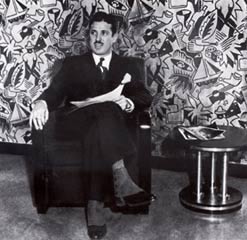Product Description
Donald Deskey, Barrels, Gelatin silver print, c.1925-30


DONALD DESKEY (1894-1989) USA
Barrels c.1925-30
Silver gelatin print, ebonized textured wood frame
Provenance: The Estate of Donald Deskey
H: 9 7/8” x W: 7 15/16”
Framed: H: 22” x W: 18”
Price: $4,200
Donald Deskey was a native of Blue Earth, Minnesota. He studied architecture at the University of California, but did not follow that profession, becoming instead an artist and a pioneer in the field of Industrial design. In Paris he attended the 1925 Exposition Internationale des Arts Décoratifs et Industriels Modernes, which influenced his approach to design. He established a design consulting firm in New York City, and later the firm of Deskey-Vollmer (in partnership with Phillip Vollmer) which specialized in furniture and textile design. His designs in this era progressed from Art Deco to Streamline Moderne.
He first gained note as a designer when he created window displays for the Franklin Simon Department Store in Manhattan in 1926. In the 1930's, he won the competition to design the interiors for Radio City Music Hall. In the 1940's he started the graphic design firm Donald Deskey Associates and made some of the most recognizable icons of the day. He designed the Crest toothpaste packaging, as well as the Tide bullseye. His company is still in operation in Cincinnati. A collection of his work is held by the Cooper-Hewitt, National Design Museum. He is regarded the American pioneer of industrial design, and contemporary American graphic design.
Donald Deskey, Barrels, Gelatin silver print, c.1925-30
GYÖRGY KEPES (1906-2001) Hungary/USA
Abstraction 1942
Silver gelatin print
Signed: Gyorgy Kepes 1942 (in ink on back)
Framed size: H: 18 13/16” x W: 16”
György Kepes was a Hungarian-born painter, designer, educator and art theorist. After emigrating to the U.S. in 1937, he taught design at the New Bauhaus (later the School of Design, then Institute of Design, then Illinois Institute of Design or IIT) in Chicago. In 1947 He founded the Center for Advanced Visual Studies at the Massachusetts Institute of Technology (MIT) where he taught until his retirement in 1974.
DONALD DESKEY attributed (1894-1989) USA
DESKEY-VOLLMER, INC. (maker)
Modernist intersecting-circles store display c.1928-30
Chrome-plated sphere and cylindrical shaft and details, original plate glass shelves and mirrored base
***This store display piece is exceptional quality and survives in mint condition.
For more information and related designs see: Donald Deskey: Decorative Designs and Interiors, David A. Hanks and Jennifer Toher, E.P. Dutton: New York, 1987, pages 12-17 and 96-98 (Abby Rockefeller table centerpiece)
H: 8 ¾” x W: 11” x D of base: 10 ¼”
